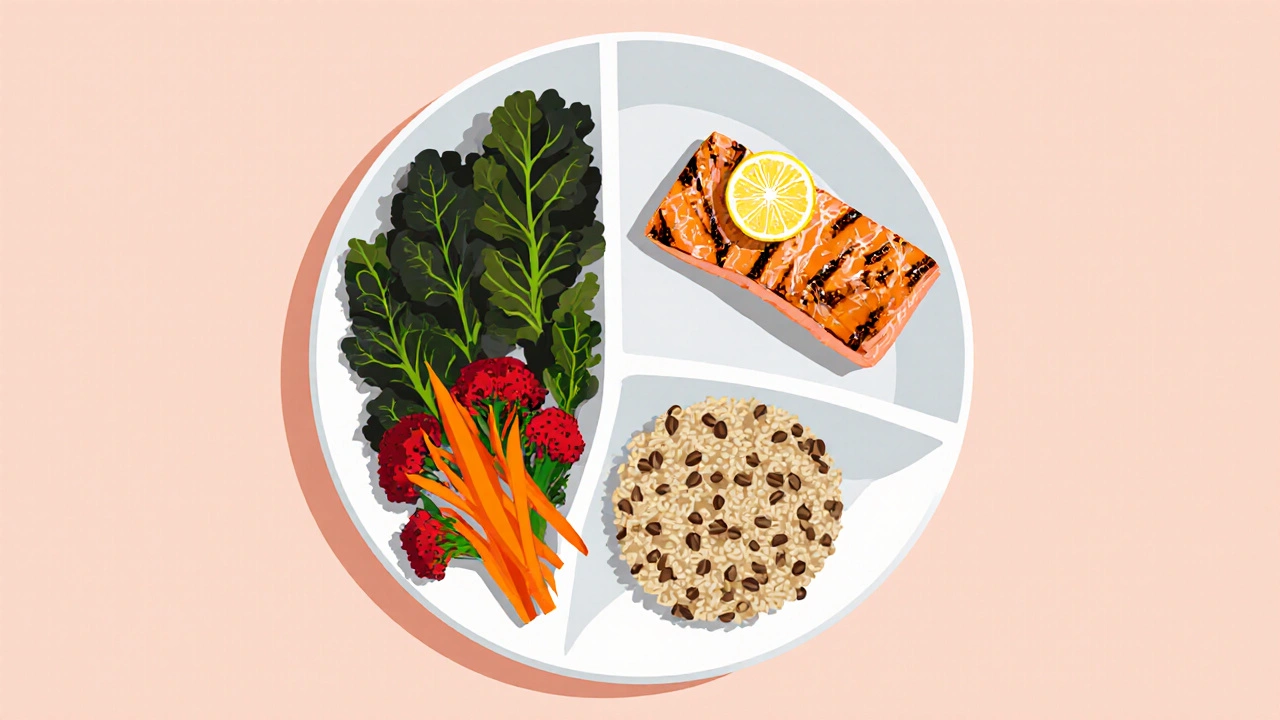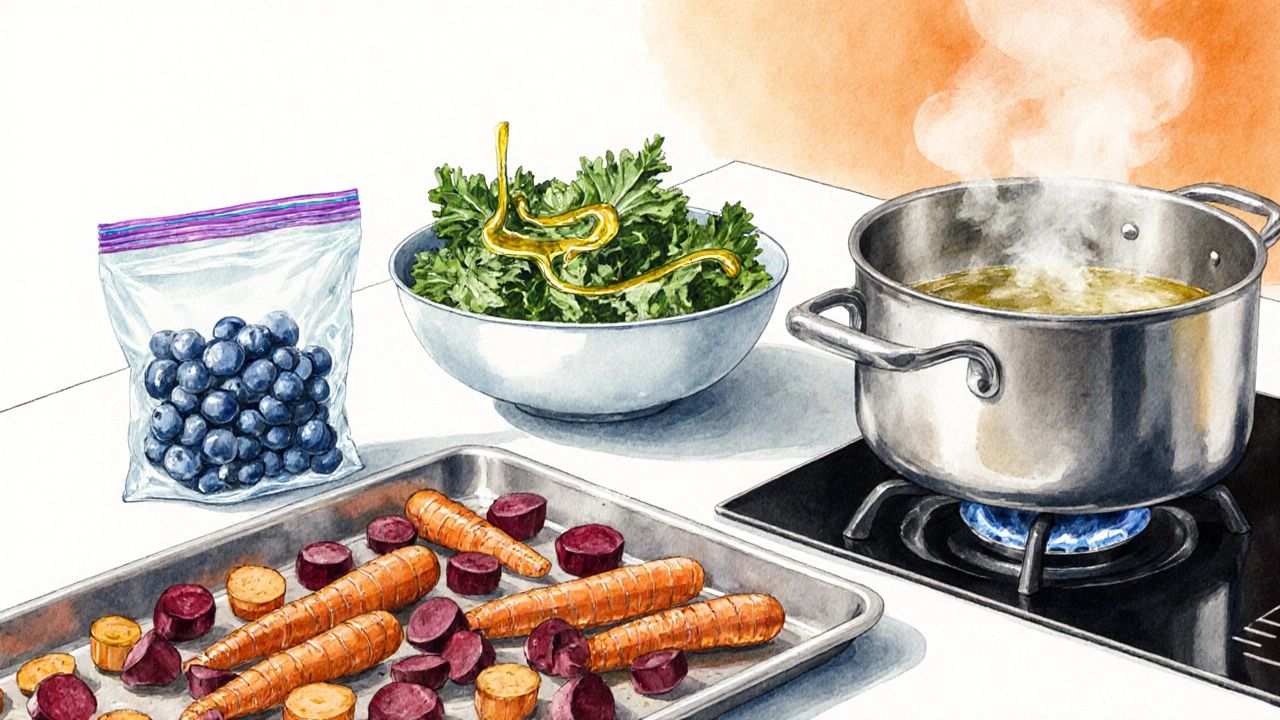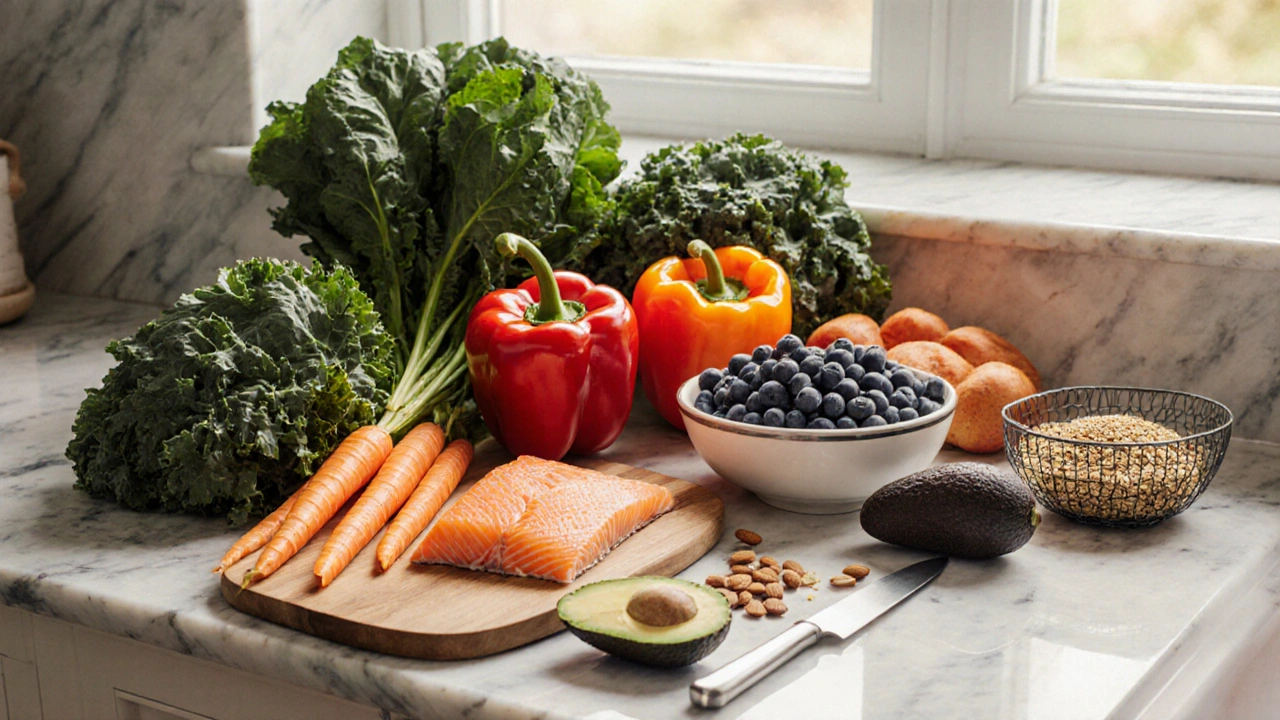Key Takeaways
- Identify the top vitamin‑rich food groups and add them to every meal.
- Use a simple plate‑model to balance vitamins, protein, fiber, and healthy fats.
- Prep once, eat well all week - batch‑cook, freeze, and repurpose ingredients.
- Track your intake against the Recommended Dietary Allowance (RDA) to avoid gaps.
- Swap cooking methods to keep vitamins intact while boosting flavor.
Getting enough vitamins doesn’t have to be a chore. By weaving vitamin-rich foods into the meals you already eat, you can boost energy, support immunity, and keep skin, eyes, and bones in top shape without counting pills. Below is a step‑by‑step guide that turns everyday meal planning into a nutrient‑fuelled routine.
What makes a food "vitamin‑rich"?
When nutrition experts talk about vitamin‑rich foods they mean items that deliver a high amount of micronutrients per calorie. Vitamins are organic compounds that our bodies need in small quantities to run biochemical processes such as metabolism, immune response, and tissue repair. Unlike macronutrients (carbs, protein, fat), a gram of vitamins supplies virtually no energy, but they act like the "switches" that let enzymes work correctly.
Micronutrients differ from macronutrients in two key ways: they are required in milligram or microgram amounts, and they cannot be synthesized in sufficient quantities by the body. That’s why we rely on food sources to meet the Recommended Dietary Allowance (RDA) set by health authorities.
How to build a vitamin‑focused plate
Start with a visual cue: the Meal planning framework that splits your plate into sections. A half‑plate of colorful vegetables, a quarter of lean protein, and a quarter of whole‑grain carbs gives you a base that naturally includes many vitamins. Here’s how to tweak each section for a vitamin boost.
- Vegetable quarter: Choose a mix of dark leafy greens (spinach, kale) for Vitamin K and A, orange veggies (carrots, sweet potatoes) for Vitamin A and beta‑carotene, and cruciferous veg (broccoli, Brussels sprouts) for Vitamin C.
- Protein quarter: Opt for fish (salmon, sardines) for Vitamin D and B‑12, poultry for B‑complex, and legumes for folate (Vitamin B9).
- Carb quarter: Pick whole grains like quinoa and brown rice, which provide B‑vitamins, and add a side of fruit (berries, citrus) for extra Vitamin C and antioxidants.
By rotating colors and textures daily, you’ll hit most vitamins without having to calculate each one.

Food groups that punch above their weight
The following table lines up the six fat‑soluble and water‑soluble vitamin families with the foods that deliver the most per serving. Use it as a quick reference when grocery shopping.
| Vitamin | Top Food Sources (per 100g) | Average RDA (Adult) |
|---|---|---|
| VitaminA (Retinol) | Carrot (828µg), Sweet potato (709µg), Spinach (469µg) | 900µg (men), 700µg (women) |
| VitaminB1 (Thiamine) | Whole wheat (0.5mg), Pork (0.8mg), Sunflower seeds (1.1mg) | 1.2mg (men), 1.1mg (women) |
| VitaminC | Red bell pepper (128mg), Kiwi (93mg), Broccoli (89mg) | 90mg (men), 75mg (women) |
| VitaminD | Salmon (526IU), Mackerel (360IU), Fortified milk (120IU) | 600IU (up to age70) |
| VitaminE | Almonds (25mg), Sunflower oil (41mg), Avocado (14mg) | 15mg |
| VitaminK | Kale (817µg), Natto (1103µg), Broccoli (141µg) | 120µg (men), 90µg (women) |
Sample day of meals - all vitamin‑rich, no extra effort
Below is a breakfast‑to‑dinner plan that hits at least 80% of each RDA using everyday ingredients. Adjust portions to match your calorie goals.
- Breakfast: Greek yogurt (200g) topped with fresh blueberries (½ cup) and a sprinkle of chopped almonds (1tbsp). Provides VitaminC, E, and B‑complex.
- Mid‑morning snack: A medium orange and a hard‑boiled egg. Delivers VitaminC and A‑rich yolk.
- Lunch: Quinoa salad with grilled salmon (120g), baby spinach, cherry tomatoes, and olive‑oil dressing. Packs VitaminsD, A, K, and B‑12.
- Afternoon snack: Carrot sticks with hummus. Adds VitaminA and folate.
- Dinner: Stir‑fried broccoli, bell pepper, and tofu in ginger‑garlic sauce, served over brown rice. Supplies VitaminsC, K, and several B‑vitamins.
The plan uses three cooking methods-raw, sauté, and baking-to preserve different vitamin groups. Heat can destroy Vitamin C, so keep at least one raw fruit or veg each day.

Practical prep tips to keep vitamins alive
Putting theory into practice is where most people slip. Here are five habits that make vitamin‑rich eating sustainable.
- Batch‑cook smart: Roast a tray of mixed root vegetables (carrots, sweet potatoes, beets) on Sunday. Store in airtight containers-roasting at 400°F for 30minutes retains most VitaminA and K.
- Freeze for freshness: Freeze berries in single‑serve bags. Frozen fruit keeps VitaminC well because the flash‑freeze stops oxidation.
- Quick‑steam greens: Steam kale or broccoli for just 3‑4minutes. Longer cooking leaches water‑soluble vitamins into the steam, which you can capture by adding a splash of broth to the dish.
- Use acidic dressings: A squeeze of lemon or a splash of vinegar improves iron absorption and stabilizes VitaminC during storage.
- Rotate your protein: Alternate salmon, sardines, chicken, and legumes throughout the week to cover VitaminsD, B‑12, and folate without relying on supplements.
Common pitfalls and how to avoid them
Even with a solid plan, a few mistakes can sap your vitamin intake.
- Over‑cooking: Boiling vegetables for a long time drags out water‑soluble vitamins. Opt for steaming, microwaving, or quick stir‑fry.
- Skipping fats: Fat‑soluble vitamins (A, D, E, K) need dietary fat for absorption. Add a drizzle of olive oil, avocado, or nuts to salads.
- Relying solely on juices: Freshly squeezed juice loses fiber and can spike blood sugar. Keep whole fruit for the fiber and steady vitamin release.
- Ignoring portion sizes: More isn’t always better. Excessive liver, for example, can overshoot VitaminA and become toxic.
By staying mindful of these traps, you’ll preserve the nutritional payoff of each meal.
Mini FAQ - your quick vitamin‑rich answers
How many servings of vitamin‑rich foods should I eat each day?
Aim for at least five servings of colorful fruits and vegetables, plus two servings of protein sources that contain micronutrients (fish, poultry, legumes). This mix typically meets 80‑90% of the RDA for most vitamins.
Can I get enough vitamins from a plant‑based diet?
Yes, if you include fortified foods and a variety of legumes, nuts, seeds, leafy greens, and orange vegetables. VitaminB12 and D may need fortified sources or occasional supplementation.
Does cooking destroy all vitamins?
Heat mainly affects water‑soluble vitamins (C and B‑complex). Short, gentle cooking methods preserve most of them, while fat‑soluble vitamins are stable but need some dietary fat to be absorbed.
How can I track my vitamin intake without a fancy app?
Keep a simple notebook: jot down each meal’s main vitamin source and compare it to the table above. Over a week you’ll see patterns and gaps you can fill.
Is it okay to take a multivitamin if I already eat vitamin‑rich foods?
Most healthy adults don’t need extra pills if they meet RDAs through food. Over‑supplementation can cause toxicity, especially with VitaminsA, D, E, and K. Consult a dietitian before adding a supplement.
By following these steps, you turn meal planning into a habit that fuels your body with the vitamins it craves. Start small-add one new vitamin‑rich ingredient each week-and watch your energy, skin, and overall health improve.


Author
Mike Clayton
As a pharmaceutical expert, I am passionate about researching and developing new medications to improve people's lives. With my extensive knowledge in the field, I enjoy writing articles and sharing insights on various diseases and their treatments. My goal is to educate the public on the importance of understanding the medications they take and how they can contribute to their overall well-being. I am constantly striving to stay up-to-date with the latest advancements in pharmaceuticals and share that knowledge with others. Through my writing, I hope to bridge the gap between science and the general public, making complex topics more accessible and easy to understand.